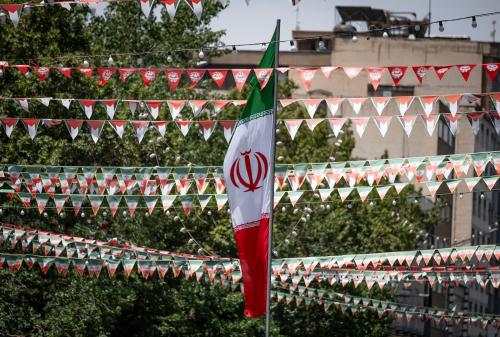What kind of shape is our military in today? Is it suffering from “long neglect,” as Texas Gov. George W. Bush asserted last Monday in a speech to the Veterans of Foreign Wars convention? Has the Clinton-Gore administration overused and underfunded the armed forces during the past eight years, leaving two Army divisions simply unready for combat, as Bush stated at the Republican National Convention? Or, as Vice President Gore and his running mate claimed in rebuttal, is the U.S. military in outstanding condition?
Political campaigns are not noted for sticking to the facts, but in this particular dispute, the Democrats’ claims are (mostly) right. Today’s military, while somewhat strained and overworked, remains strong and competent enough to handle the kinds of missions contemplated by current Pentagon plans. And, as Gen. Henry H. Shelton, the chairman of the Joint Chiefs of Staff, pointed out, Bush was plainly wrong when he said in his speech that two Army divisions are unready for duty.
But there is more to the issue than most of the campaign rhetoric would suggest, and a well-informed debate about difficult strategic issues—such as the purpose and practicality of a national missile defense—would serve the country well.
Although there are dozens of ways to assess the readiness of our armed forces, they can be grouped into four main categories. The Clinton-Gore administration deserves a high grade in two categories, a mediocre grade in one and an “incomplete” for the last.
Readiness of Individual Units: Grade, A-. By the most literal and urgent measure of readiness—the immediate ability to carry out their assigned tasks—most U.S. forces are in good shape, even if they have fallen off somewhat from the early 1990s.
Consider first the men and women of the military. Personnel are more experienced and better educated than ever. Anyone who doubts the abilities of U.S. troops need only review their outstanding performance in last year’s Kosovo war, ongoing peacekeeping missions in the Balkans and the no-fly zone operations over Iraq. Even in the ill-fated Somalia mission of 1993, troops performed ably; it was the Clinton administration and top military officials who mishandled the mission.
As for available weaponry, although most U.S. military equipment is not in quite as good shape as it was a decade ago, it is comparable to the condition of weaponry during the Reagan era. The armed forces generally measure equipment readiness in terms of “mission capable rates”—the percentage of weapons that are immediately usable for major combat tasks, and not awaiting repair or otherwise out of commission. Although actual rates vary greatly from one weapon to another, “mission capable” rates were typically about 75 percent in the 1980s and 85 percent in the early ’90s; they are generally back around 75 percent today. Historically, that is pretty good.
Altogether, the quality of people, equipment and training has given us a military in very fine shape. In addition, it has produced a very good safety record: Accident rates per person during training and deployments are lower than they have ever been, according to Pentagon data.
Ability to Execute War Plans: Grade, A-. What about readiness in a broader sense—the overall capacity of the U.S. military to carry out likely wartime missions?
Since the time of the Bush administration, the Pentagon has considered simultaneous all-out wars against two medium-sized powers, most likely Iraq and North Korea, to be its most demanding plausible combat scenario. The Clinton-Gore administration cut the size of the military about 15 percent beyond what the Bush administration had planned, which presumably has weakened the ability of the armed forces to execute this rather demanding and perhaps unrealistic two-front operation.
But it must be pointed out that the threats have gotten smaller, too. Iraq and North Korea have each suffered 10 years of economic and military stagnation. Iraq remains under sanctions, and is not even half as strong militarily as it was in 1990. In addition, South Korea, our ally on the peninsula, has continued to improve its already-strong military.
For their part, the U.S. armed forces may be smaller, but they have partly compensated by becoming more proficient at rapid deployment. They also have purchased new weapons—some of which were used in the 1999 war against Serbia—that give them more punch per person.
The U.S. military might encounter problems if it had to fight two Desert Storms at once, as official war plans nominally require. But the odds are small that it would have to do so. Even if two wars occurred at roughly the same time, it’s unlikely they would each require the half-million troops who served in the 1991 Persian Gulf War.
Sustaining Readiness in the Coming Decade: Grade, B/B-. Although things look good today, there are cracks in the U.S. military that, if allowed to worsen, could change the basic readiness picture within a few years. Some were almost unavoidable, given the new demands of the post-Cold War world, and some are being fixed today. But troubles remain.
Morale is not very high these days. Troops feel overworked, and the services are having trouble attracting and holding on to people. Recent pay raises and efforts to make overseas deployments more predictable have improved some of these trends this year. But the situation remains worrisome, and requires further steps to reduce the strain on people (such as increasing the numbers of specialized units that are frequently deployed).
Remedies are also needed on the hardware front. Much of the equipment bought during the Reagan era is starting to wear out. Combat jets, for example, will soon average 15 years in age—and it is generally thought prudent to retire them after about 20 years of service. So while near-term equipment readiness is good, a new administration will need to act fast to keep it that way in 2005 and 2010. Modest spending increases may be necessary.
Preparing for Future Threats: Grade, Incomplete. The Clinton-Gore administration has worked hard to prevent new threats from developing around the world. It has taken numerous steps to reduce our vulnerability to terrorism; aided Russia in securing its dilapidated and oversized nuclear weapons complex so “loose nukes” do not fall into the wrong hands; weaned North Korea away from its nuclear weapons program; and improved protection for U.S. troops against possible enemy use of chemical or biological weapons.
But the administration has not done enough in other areas. For example, it has not attempted to stand U.S. and Russian nuclear forces down from their states of “hair-trigger” and dangerous alert; has made only limited progress in helping Russia restore economic and political stability; and has cut funding for military science and technology research that could be of general benefit in addressing future threats (cuts that Bush, to his credit, wants to reverse).
And on one of this year’s hottest political issues—a national missile defense—it has not found a workable technology or a credible diplomatic strategy for deployment. Gore would do well to break with President Clinton, who is still clinging to a relatively unpromising missile defense technology and a rushed schedule that makes neither diplomatic nor strategic sense. That approach has won few supporters and many critics around the world.
On these longer-term issues, there are no clear answers, but plenty of room for debate. Bush should give up his overheated and mistaken rhetoric about a hollow U.S. military, and focus on these critical matters for future American security and long-term readiness. The country would be better served if he does.
The Brookings Institution is committed to quality, independence, and impact.
We are supported by a diverse array of funders. In line with our values and policies, each Brookings publication represents the sole views of its author(s).



Commentary
Op-edA Look At…The Readiness Debate
August 27, 2000